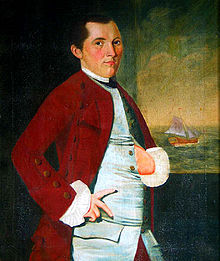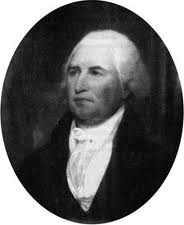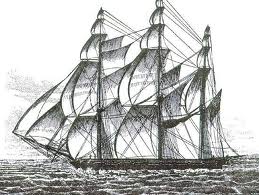
Patriot Pirates by Robert H. Patton
 The grandson of WWII General George Patton has written an intriguing and boisterous account of the American Revolution.  As the subtitle states, the book is about “The Privateer War for Freedom and Fortune in the American Revolution.â€Â Even those who consider themselves well versed on the Revolutionary period will find much within these covers that they do not know. As one naval historian has observed, “The great battles of the American Revolution were fought on land, but independence was won at sea.â€
The grandson of WWII General George Patton has written an intriguing and boisterous account of the American Revolution.  As the subtitle states, the book is about “The Privateer War for Freedom and Fortune in the American Revolution.â€Â Even those who consider themselves well versed on the Revolutionary period will find much within these covers that they do not know. As one naval historian has observed, “The great battles of the American Revolution were fought on land, but independence was won at sea.â€
Privateering, Patton explains, has a long history. For centuries nations at war had authority under international law to license independent operators to raid the shipping of a declared foe. Congress followed that tradition when it licensed citizen-sailors to go after British shipping.
George Washington, known as the father of his country, is also the progenitor of American piracy. In 1775, when the Continental Army was stalled in the siege of Boston, George Washington began what was to become, in Patton’s words “a massive seaborne insurgency involving thousands of privately owned warships whose ravages on the enemy dwarfed those of the fledgling Navy.â€
The beginning of the “seaborne insurgency†was modest. Washington armed several ships and instructed their captains to raid British shipping. He offered a percentage of the spoils to induce citizen sailors to sign on. Washington sought to “sink Britain under the disgrace and expense†that would make the cost of victory prohibitive. As Robert Morris, financier to the American Revolution, remarked of the British, “They have much more property to lose than we have.”
Privateering served multiple purposes from the beginning. It helped to provision the Continental Army, it interfered with trade, costing British merchants dearly, and it was an ongoing embarrassment to the crown, eroding British morale and support for the war.
 In addition, the privateers became pawns in the political and diplomatic machinations of Benjamin Franklin. Franklin was in France to obtain a desperately needed treaty of alliance with America. He sought to worsen relations between the two old antagonists, England and France. In pursuit of that goal, Franklin quietly encouraged American privateers to sell English plunder in French ports. The wily Franklin hoped to provoke a war between the two and thus put France solidly in the American camp.
In addition, the privateers became pawns in the political and diplomatic machinations of Benjamin Franklin. Franklin was in France to obtain a desperately needed treaty of alliance with America. He sought to worsen relations between the two old antagonists, England and France. In pursuit of that goal, Franklin quietly encouraged American privateers to sell English plunder in French ports. The wily Franklin hoped to provoke a war between the two and thus put France solidly in the American camp.
The British, incensed at this violation of French neutrality, dispatched swarms of diplomatic protests to Franklin and to the French. Franklin apologized profusely, but claimed to be both innocent and powerless to stop the practice. Count de Vergennes, the French foreign minister, enjoying the opportunity to chafe the English, was happy to conspire with the Americans.
Patton takes the reader behind the scenes to the investors who bought the ships and outfitted them, and the captains who, while complaining mightily about their share of the prize money, repeatedly took on the Royal Navy.
 The patriots and pirates who populate these pages often, but not always, resided in the same bodies.  Among lesser-known individuals who played key roles, are Silas Deane, John and Moses Brown, William Coit, and Edward Bancroft. The well-connected Bancroft, it was later revealed, was a British spy. He was concerned neither with American patriotism nor with British loyalty. He was in it for the money.
The patriots and pirates who populate these pages often, but not always, resided in the same bodies.  Among lesser-known individuals who played key roles, are Silas Deane, John and Moses Brown, William Coit, and Edward Bancroft. The well-connected Bancroft, it was later revealed, was a British spy. He was concerned neither with American patriotism nor with British loyalty. He was in it for the money.
Patton’s book is filled with patriots and scoundrels so linked that it is sometimes difficult to tell where one leaves off and the other begins. Patton describes how privateering became very much a part of Revolutionary life. It involved seaman, dock hands and members of Congress and generated a network of agents of dubious honesty who sold the captured goods and spurred speculators to purchase shares in privateer ventures. General Nathaniel Greene, who figures prominently in the book, was at times both an unwilling participant and a man eager to make up for the erosion of his personal finances caused by his military service.
The more than 2,000 privately owned warships that sailed against the British took enormous risks. In 1777, parliament passed the Pirate Act which denied privateers the legal rights afforded prisoners of war and, in effect, subjected them to the worst conditions of captivity.
The lucky gained fortunes for themselves and their investors; the not so lucky went broke when ships and expected profits were lost. The captured crews confined in the prison ships described in horrendous detail by Edwin Burrows in his book, Forgotten Patriots, (reviewed here) were unluckiest of all. “Most of the dead were privateersmen,†Patton writes. “Their bodies were thrown overboard or buried by fellow inmates in the sand banks edging the bay.â€
 Not everyone welcomed the seaborne insurgency. Much to John Paul Jones’ dismay, it dwarfed the efforts of the small Continental Navy. Jones, who considered the privateers little better than criminals, found it increasingly difficult to obtain recruits for the Navy when sailors could make more money in a month aboard a privateer than they might otherwise earn in a year of Navy service. Much as Jones despised the privateers, the lure of profit was so great that before the war was over he determined to become an investor.
Not everyone welcomed the seaborne insurgency. Much to John Paul Jones’ dismay, it dwarfed the efforts of the small Continental Navy. Jones, who considered the privateers little better than criminals, found it increasingly difficult to obtain recruits for the Navy when sailors could make more money in a month aboard a privateer than they might otherwise earn in a year of Navy service. Much as Jones despised the privateers, the lure of profit was so great that before the war was over he determined to become an investor.
The majority of Patton’s  book is made up of chronological and geographic vignettes about the various individuals involved, in one capacity, or another, in privateering. The stirring tales of daring on the high seas are as exciting as any spun by Patrick O’Brian in his series about the British Navy. The difference is that the people in Patton’s adventures are real.
In the last chapters of the book, the author reveals the fate of the participants, famous and infamous. Some were well rewarded for their efforts, but politics, personal rivalries and human nature being what it is, others, though they served at great sacrifice to themselves and their families were not necessarily among that fortunate number.
According to Patton, in addition to telling a rousing good story, his purpose in writing the book was to rectify the neglect of privateering in the defeat of the British. He does it exceedingly well. In addition, he provides portraits of the people he writes about with informative captions. His research is thorough and his prose is crisp with unexpected reservoirs of humor. This book should be on the reading list of every Revolutionary War buff.
 The posts are coming!
The posts are coming!

0 comments
Kick things off by filling out the form below.
Leave a Comment